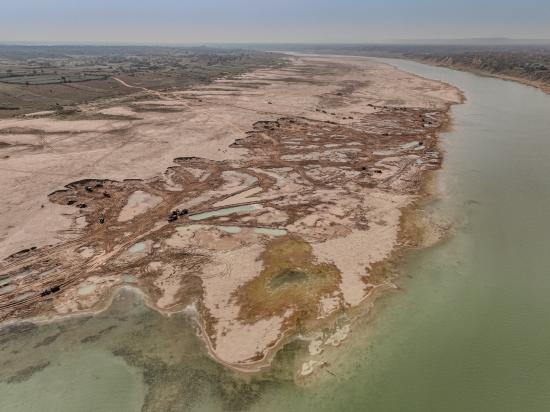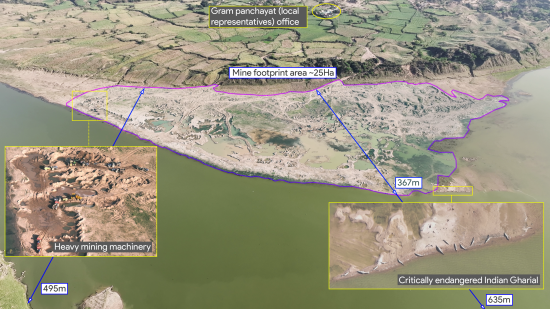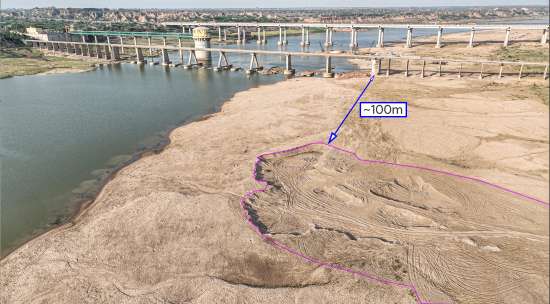New Research Aims to Curb Illegal Sand Mining with Data-Driven Mapping Tools

You may have heard of deforestation and/or water extraction, but have you heard of sand mining? Described as “one of the greatest sustainability challenges in the 21st century” by the United Nations Environment Programme, sand mining refers to the often illegal extraction of construction-grade sand from rivers and beaches to create concrete, asphalt, and glass. In recent years, urbanization and economic growth have led to the demand for sand to skyrocket, resulting in environmental and social crises in river basins across the world.
A group of scholars from the School of Information are tackling this issue with the help of a grant from the Mozilla Technology Foundation (MTF) and collaborators from India. Ph.D. students Suraj Nair and Ando Shah, alongside Professor Joshua Blumenstock, are spearheading the creation of Sand Mining Watch, a set of open-source tools to enable the production of high-resolution maps of sand-mining activity around the world.

“By combining deep learning methods and freely available satellite imagery, we hope to automate the process of detecting sand mining activity at scale,” said Nair and Ando (who prefers to go by his first name).

“We both saw a large gap in the academic literature as well as a lack of practical ways to monitor this huge problem…We decided to use our experience with using computational tools for social and environmental monitoring to tackle this problem.”
— Ando Shah and Suraj Nair
“We both saw a large gap in the academic literature as well as a lack of practical ways to monitor this huge problem…We decided to use our experience with using computational tools for social and environmental monitoring to tackle this problem.”

For now, the team is setting its sights on India, a country with fertile lands and large sediment loads. Both Nair and Ando grew up in the country and witnessed the pervasiveness of sand mining throughout their time there, especially in rural areas. Their familiarity with the culture and geography made India the perfect place to pilot this project.
“The problem of sand mining is particularly acute in India where a very powerful sand mafia has emerged to control this important resource,” Ando explained. “India also has the largest construction industry in the world with a very aggressive infrastructure development program, all of which needs copious amounts of sand for building bridges, roads, dams, high rises, hospitals and almost every other kind of infrastructure.”
They partnered with the Veditum Foundation, a non-profit research, media, and action-oriented organization based in India, to pilot and evaluate the performance of their deep learning models in the region. They hope these models will be able to detect sand mining activity in river basins and catalyze policy action, improve the monitoring and regulation of illegal mining activity, and help everyday people better understand the socio-economic and environmental impacts of sand mining.
The team is supported by the Mozilla Technology Foundation’s AI for Environmental Justice program, which provided the group with $50,000 and one year of mentorship.
“We are very excited to be included in the Mozilla Technology Foundation’s 2024 cohort of awardees! It’s a great opportunity to interact and learn from researchers and practitioners who are building open-source AI tools to address some of the pressing environmental challenges facing the planet today,” Nair noted. “The MTF grant has allowed us to conduct fieldwork in India which has been crucial to this work, as well as acquire additional computers and help make the project sustainable.”
“For the research community, this project helps illustrate how AI algorithms can be applied to novel sources of data in order to learn about the lasting consequences of environmental degradation.”
— Joshua Blumenstock
Professor Blumenstock added, “I think this project has the potential to impact both policy and research. The team is working closely with local Indian organizations trying to put a stop to illegal sand mining, and this work can help front line organizations more quickly and efficiently identify areas being mined. For the research community, this project helps illustrate how AI algorithms can be applied to novel sources of data in order to learn about the lasting consequences of environmental degradation.”
Related
Fellowship Recipients Seek to Innovate and Empower Meaningful Change
Seven School of Information students have been awarded fellowships for 2023-24. From research on tracking natural disasters to migration, these scholars are pushing the boundaries of cybersecurity, data science, and information science.
Human-Computer Interaction Research De-Centers Humans to Give Nature a Voice
In response to recent calls for researchers to address ongoing environmental crises, School of Information Ph.D. student Yangyang Yang and Professor Kimiko Ryokai have created “Being The Creek,” a project that utilizes mobile augmented reality (MAR) to help people experience Berkeley’s natural...
Climate Change as an Information Problem
Catherine Cronquist Browning, the assistant dean of academic programs and of equity and inclusion at the I School, argues that climate change is an information problem.
